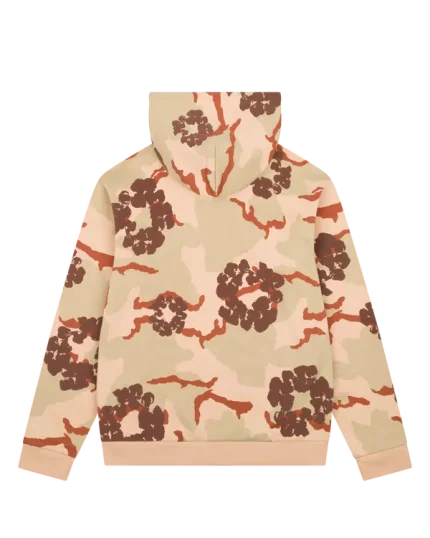The Story of Denim Tears: Culture, Fashion, and Bold Expression
Introduction: A Cultural Movement Woven into Denim Fashion is often more than clothing—it is a language, a tool for resistance, and a marker of identity. In recent years, one label has risen to embody these ideals with rare authenticity: Denim Tears. Founded by Tremaine Emory, the brand has become a symbol of cultural storytelling, using denim and cotton as mediums to explore history, heritage, denim tears and resilience. More than a fashion line, Denim Tears is a statement of identity, a confrontation with uncomfortable truths, and a bold step toward reshaping how we view both clothing and culture. The Origins of Denim Tears Tremaine Emory, a creative director and cultural figure who has worked alongside brands like Stüssy, Supreme, and Kanye West’s Yeezy, founded Denim Tears in 2019. His vision was deeply personal, inspired by his roots and the legacy of African American history. Denim Tears was not conceived as just another fashion brand; instead, it was born out of Emory’s desire to reflect on the painful history of cotton in America and reframe its narrative through art and fashion. Denim has long symbolized resilience, rebellion, and everyday life, while cotton is a fabric with a history tied to exploitation, slavery, and systemic oppression. By merging the two in a symbolic and visually striking way, Emory gave voice to centuries of untold stories. Denim Tears is, at its core, a memorial and a celebration—a brand that forces the world to look at history while celebrating the creativity and endurance of Black culture. The Iconic Cotton Wreath Design One of Denim Tears’ most recognizable motifs is the cotton wreath, which appears embroidered on jeans, jackets, and hoodies. At first glance, the wreath may seem like a simple floral embellishment, but its meaning runs deep. Cotton was the backbone of the transatlantic slave economy, cultivated by enslaved Africans whose labor fueled global industries. The wreath, therefore, is both a reminder of suffering and a reclaiming of cultural ownership. By wearing Denim Tears, individuals participate in an act of remembrance. The clothes become conversation starters, forcing society to engage with histories often overlooked in mainstream culture. At the same time, the brand transforms this symbol into one of empowerment, turning a marker of exploitation into an emblem of endurance, resistance, and pride. Collaborations That Shape the Narrative Denim Tears has gained widespread attention not only through its symbolic imagery but also through its powerful collaborations. In 2020, the brand partnered with Levi’s to release a collection featuring the cotton wreath embroidered on the iconic 501 jeans. The collaboration was more than a merging of aesthetics; it was a confrontation between America’s denim legacy and its hidden histories of oppression. Levi’s, a staple of American culture, became a canvas for Emory’s storytelling, forcing consumers to reckon with the paradoxes embedded in everyday clothing. Beyond Levi’s, Denim Tears has worked with Converse, creating sneakers adorned with designs that reflect African heritage and spiritual symbolism. Each collaboration is not just about fashion but about dialogue—expanding the reach of Denim Tears’ message and weaving history into mainstream fashion culture. Denim Tears as Protest and Expression Denim Tears occupies a unique space where fashion meets activism. The brand does not shy away from being political; instead, it embraces confrontation. Emory has described Denim Tears as a tool for protest—an art form that questions systems of oppression while celebrating Black contributions to culture. Unlike fast fashion, which often strips clothing of meaning, Denim Tears insists on depth. Every stitch and design element reflects a narrative. For many, wearing Denim Tears is not just about style but about identity, solidarity, and visibility. In this sense, the brand transforms the act of getting dressed into an act of resistance and cultural expression. The Role of Storytelling in Fashion What sets Denim Tears apart is its use of storytelling as the foundation of design. Rather than chasing trends, Emory creates collections that speak to history, trauma, and beauty. Fashion becomes a living archive, and Denim Tears garments function like pages of a cultural text. This approach resonates strongly with younger generations, who increasingly view fashion as a way to align personal identity with social values. In a world where consumers demand authenticity, Denim Tears offers something rare: clothing that carries a story, one that refuses to let history be forgotten or silenced. Global Influence and Recognition Though rooted in African American history, Denim Tears has achieved global recognition. Its message transcends borders, resonating with people who see fashion as a tool for cultural commentary. In Europe, Asia, and beyond, the brand has been celebrated for its honesty and courage. High-profile figures including Kanye West, Frank Ocean, and Virgil Abloh have worn Denim Tears, further cementing its cultural relevance. But unlike many brands elevated by celebrity endorsements, Denim Tears remains grounded in its mission. It is not about clout but about culture. Its growth reflects the hunger for fashion that speaks with purpose. The Intersection of Pain and Beauty One of the most profound aspects of Denim Tears is its ability to hold space for both pain and beauty. The cotton wreath, for example, is painful to confront because it symbolizes centuries of suffering. Yet when embroidered on denim, it becomes strikingly beautiful, even poetic. This duality reflects the human condition: resilience, creativity, and beauty emerging from oppression and trauma. Emory’s work demonstrates that fashion can hold contradictions. It can be celebratory while also being critical. It can be beautiful while also being uncomfortable. In a world where clothing often functions as mere consumer goods, Denim Tears reminds us that fashion can be art, philosophy, and protest all at once. Looking Ahead: The Future of Denim Tears As Denim Tears continues to evolve, its mission remains unchanged: to use fashion as a tool for storytelling, remembrance, and cultural empowerment. With each collection, the brand Denim Tears T Shirt deepens its narrative and broadens its audience. Emory has hinted at future projects that will further expand on African and diasporic histories, making Denim Tears a living, growing archive of Black experience. The fashion industry itself is shifting toward more authentic, meaningful design. In this landscape, Denim Tears stands as a blueprint for what socially conscious fashion can look like. It is not about empty slogans but about weaving history into every garment. Its future, therefore, looks not just bright but necessary. Conclusion: Denim Tears as a Legacy in Motion The story of Denim Tears is one of culture, fashion, and bold expression. Tremaine Emory has created more than a clothing brand; he has built a cultural project that challenges, educates, and inspires. Through its symbolic imagery, collaborations, and unapologetic messaging, Denim Tears reshapes how we understand the role of fashion in society. It is a reminder that clothing is never neutral. Every thread carries meaning, every symbol tells a story, and every garment can be an act of resistance. Denim Tears teaches us that fashion, at its most powerful, is not about trends or seasons but about memory, identity, and expression. In celebrating Denim Tears, we celebrate the possibility of fashion as truth-telling, as healing, and as art. It is more than denim, more than cotton—it is history worn proudly, culture stitched into fabric, and expression that refuses to be silenced.



Leave a Comment